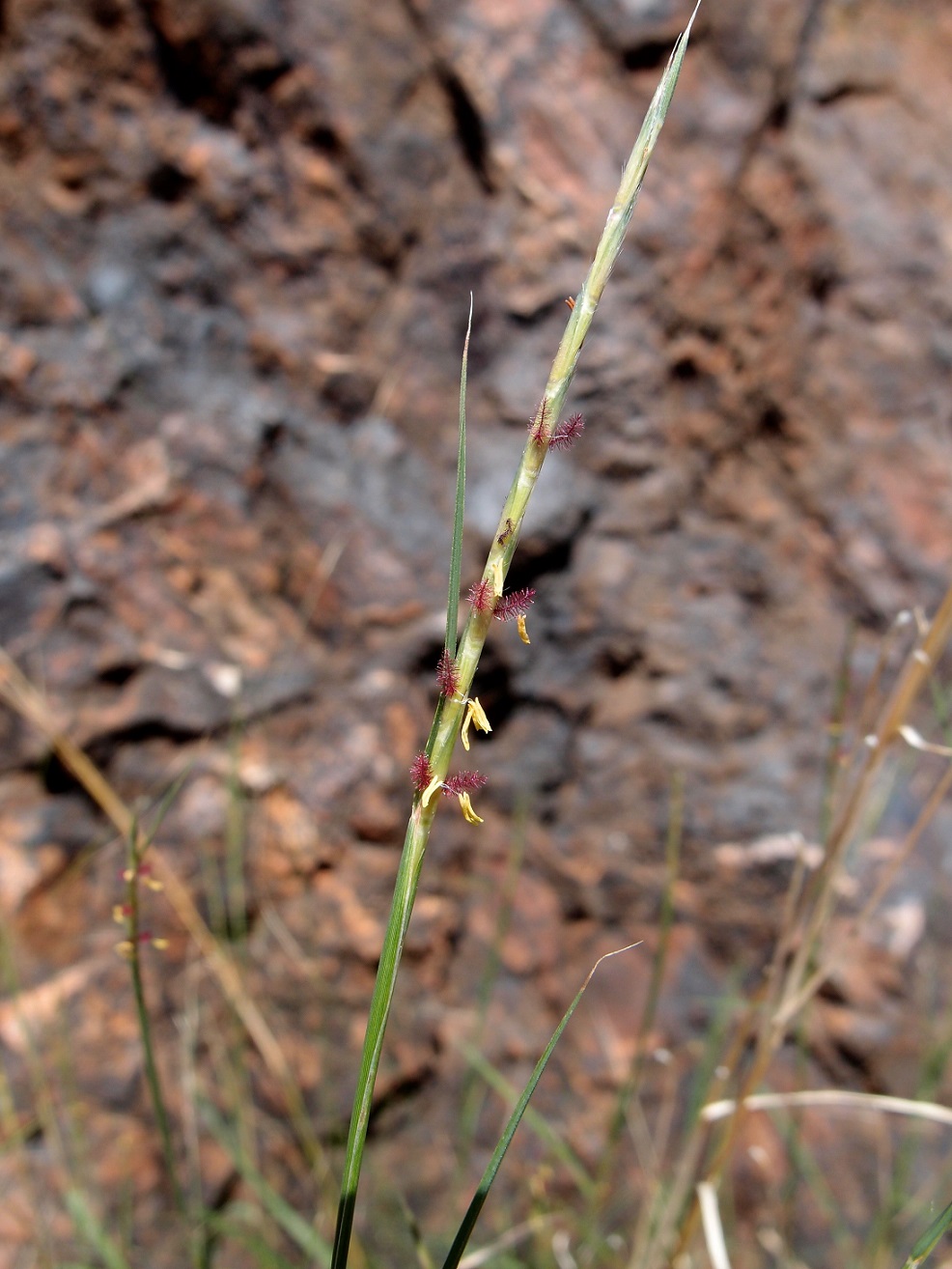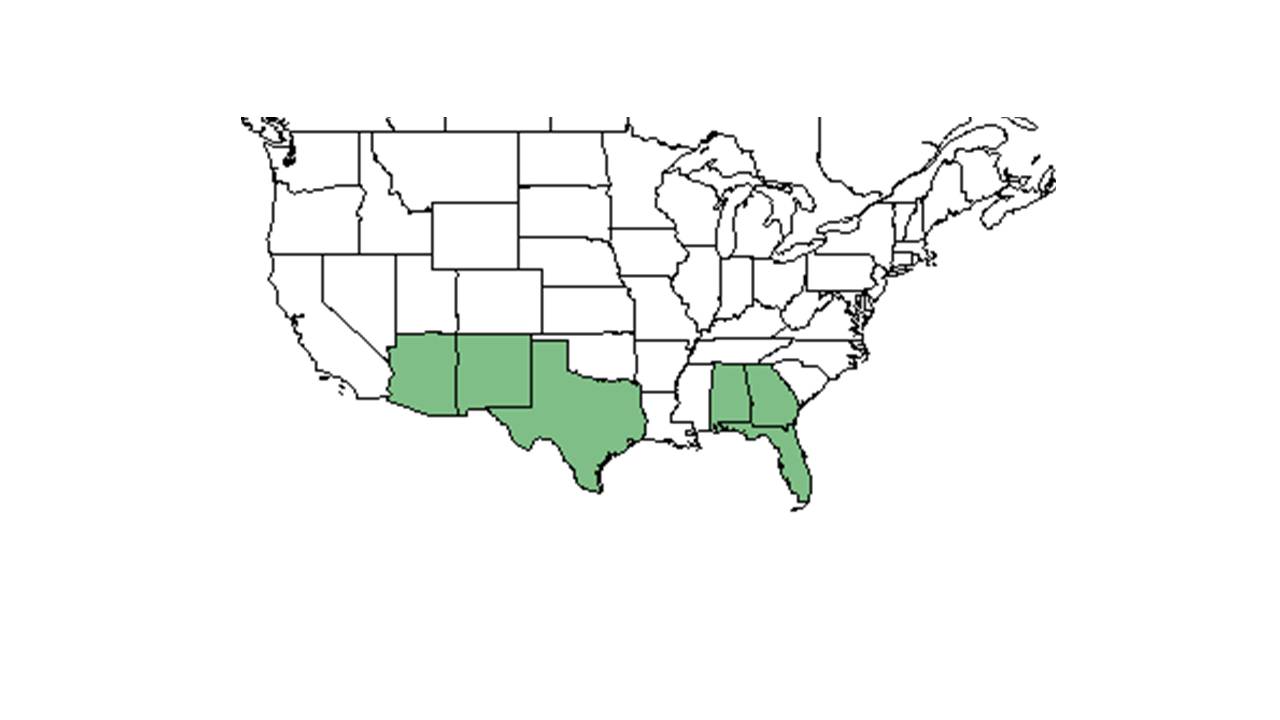Difference between revisions of "Schizachyrium sanguineum"
KatieMccoy (talk | contribs) |
HaleighJoM (talk | contribs) (→Ecology) |
||
| (20 intermediate revisions by 7 users not shown) | |||
| Line 3: | Line 3: | ||
{{taxobox | {{taxobox | ||
| name = Schizachyrium sanguineum | | name = Schizachyrium sanguineum | ||
| − | | image = | + | | image = Schi_sang.jpg |
| − | | image_caption = | + | | image_caption = Photo and permission by Sue Carnahan [http://swbiodiversity.org/seinet/index.php SEINet Arizona – New Mexico Chapter] |
| regnum = Plantae | | regnum = Plantae | ||
| divisio = Magnoliophyta – Flowering plants | | divisio = Magnoliophyta – Flowering plants | ||
| Line 15: | Line 15: | ||
| binomial_authority = (Retz.) Alston | | binomial_authority = (Retz.) Alston | ||
| range_map = SCHI_SANG_dist.jpg | | range_map = SCHI_SANG_dist.jpg | ||
| − | | range_map_caption = Natural range of ''Schizachyrium sanguineum'' from USDA NRCS [http:// | + | | range_map_caption = Natural range of ''Schizachyrium sanguineum'' from USDA NRCS [http://plants.usda.gov/core/profile?symbol=SCSA Plants Database]. |
}} | }} | ||
| − | Common name: | + | Common name: Crimson bluestem |
==Taxonomic notes== | ==Taxonomic notes== | ||
| + | Synonyms: ''Andropogon hirtiflorus'' (Nees) Kunth | ||
| + | |||
| + | Varieties: ''Schizachyrium sanguineum'' var. ''brevipedicellatum'' (Beal) Hatch | ||
| + | |||
==Description== | ==Description== | ||
<!-- Basic life history facts such as annual/perrenial, monoecious/dioecious, root morphology, seed type, etc. --> | <!-- Basic life history facts such as annual/perrenial, monoecious/dioecious, root morphology, seed type, etc. --> | ||
| Line 26: | Line 30: | ||
==Ecology== | ==Ecology== | ||
===Habitat=== <!--Natural communities, human disturbed habitats, topography, hydrology, soils, light, fire regime requirements for removal of competition, etc.--> | ===Habitat=== <!--Natural communities, human disturbed habitats, topography, hydrology, soils, light, fire regime requirements for removal of competition, etc.--> | ||
| − | In the Coastal Plain in Florida, ''S. sanguineaum'' can be found in wet hammocks, pine flatwoods on limerocks, scrub oak barrens, sandy old fields, turkey oak sand ridges, longleaf pine-deciduous scrub oak forests, and pine-scrub oak sand ridges | + | In the Coastal Plain in Florida, ''S. sanguineaum'' can be found in wet hammocks, pine flatwoods on limerocks, scrub oak barrens, sandy old fields, turkey oak sand ridges, longleaf pine-deciduous scrub oak forests, and pine-scrub oak sand ridges.<ref name="FSU Herbarium">Florida State University Robert K. Godfrey Herbarium database. URL: [http://herbarium.bio.fsu.edu http://herbarium.bio.fsu.edu]. Last accessed: July 2015. Collectors: R.K. Godfrey, Loran C. Anderson, John B. Nelson, Rhonda Riggins, Sidney McDaniel, R. Kral, D. B. Ward, J. Hunter, F. S. Ward, J. P. Gillespie. States and Counties: Florida: Calhoun, Dade, Escambia, Gilchrist, Lake, Leon, Liberty, Madison, Monroe, Okaloosa, Wakulla, Walton, Washington. Compiled by Tall Timbers Research Station and Land Conservancy.</ref> It can be found in reddish sandy soils.<ref name="FSU Herbarium"/> |
| + | |||
| + | Associated species include ''Pityopsis adenolepis, Cladonia, Warea, Crotonopsis, Lechea, Paronychia, Pityopsis aspera, Eupatorium pinnatifidum, Gnaphalium obtusifolium, Diodia teres'', centipede grass and bahia grass.<ref name="FSU Herbarium"/> | ||
===Phenology=== <!--Timing off flowering, fruiting, seed dispersal, and environmental triggers. Cite PanFlora website if appropriate: http://www.gilnelson.com/PanFlora/ --> | ===Phenology=== <!--Timing off flowering, fruiting, seed dispersal, and environmental triggers. Cite PanFlora website if appropriate: http://www.gilnelson.com/PanFlora/ --> | ||
| − | It has been recorded to flower August through November | + | It has been recorded to flower August through November.<ref name="FSU Herbarium"/> |
| + | <!--===Seed dispersal===--> | ||
| + | <!--===Seed bank and germination===--> | ||
| + | <!--===Fire ecology===--> <!--Fire tolerance, fire dependence, adaptive fire responses--> | ||
| + | <!--===Pollination===--> | ||
| + | <!--===Herbivory and toxicology===<!--Common herbivores, granivory, insect hosting, poisonous chemicals, allelopathy, etc--> | ||
| + | <!--===Diseases and parasites===--> | ||
| + | |||
| + | ==Conservation, cultivation, and restoration== | ||
| + | |||
| + | ==Cultural use== | ||
| − | |||
| − | |||
| − | |||
| − | |||
| − | |||
| − | |||
| − | |||
| − | |||
==Photo Gallery== | ==Photo Gallery== | ||
| + | <gallery widths=180px> | ||
| + | </gallery> | ||
==References and notes== | ==References and notes== | ||
Latest revision as of 11:59, 15 July 2022
| Schizachyrium sanguineum | |
|---|---|

| |
| Photo and permission by Sue Carnahan SEINet Arizona – New Mexico Chapter | |
| Scientific classification | |
| Kingdom: | Plantae |
| Division: | Magnoliophyta – Flowering plants |
| Class: | Liliopsida – Monocotyledons |
| Order: | Cyperales |
| Family: | Poaceae ⁄ Gramineae |
| Genus: | Schizachyrium |
| Species: | S. sanguineum |
| Binomial name | |
| Schizachyrium sanguineum (Retz.) Alston | |

| |
| Natural range of Schizachyrium sanguineum from USDA NRCS Plants Database. | |
Common name: Crimson bluestem
Contents
Taxonomic notes
Synonyms: Andropogon hirtiflorus (Nees) Kunth
Varieties: Schizachyrium sanguineum var. brevipedicellatum (Beal) Hatch
Description
Distribution
Ecology
Habitat
In the Coastal Plain in Florida, S. sanguineaum can be found in wet hammocks, pine flatwoods on limerocks, scrub oak barrens, sandy old fields, turkey oak sand ridges, longleaf pine-deciduous scrub oak forests, and pine-scrub oak sand ridges.[1] It can be found in reddish sandy soils.[1]
Associated species include Pityopsis adenolepis, Cladonia, Warea, Crotonopsis, Lechea, Paronychia, Pityopsis aspera, Eupatorium pinnatifidum, Gnaphalium obtusifolium, Diodia teres, centipede grass and bahia grass.[1]
Phenology
It has been recorded to flower August through November.[1]
Conservation, cultivation, and restoration
Cultural use
Photo Gallery
References and notes
- ↑ 1.0 1.1 1.2 1.3 Florida State University Robert K. Godfrey Herbarium database. URL: http://herbarium.bio.fsu.edu. Last accessed: July 2015. Collectors: R.K. Godfrey, Loran C. Anderson, John B. Nelson, Rhonda Riggins, Sidney McDaniel, R. Kral, D. B. Ward, J. Hunter, F. S. Ward, J. P. Gillespie. States and Counties: Florida: Calhoun, Dade, Escambia, Gilchrist, Lake, Leon, Liberty, Madison, Monroe, Okaloosa, Wakulla, Walton, Washington. Compiled by Tall Timbers Research Station and Land Conservancy.